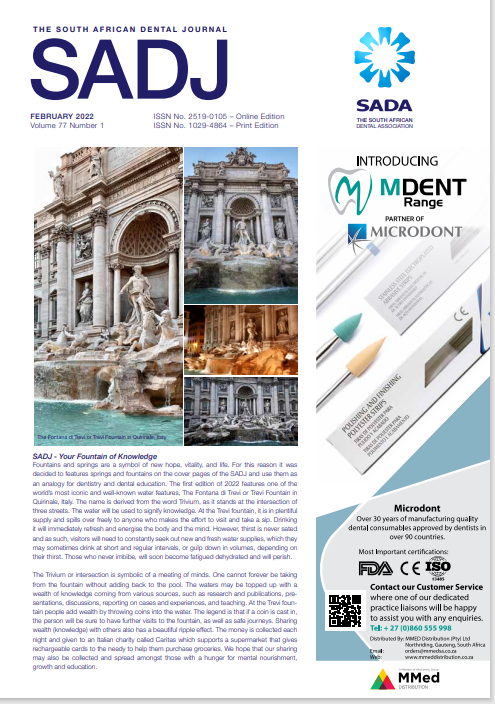Will “selfies” solve the identification crisis in lower socio-economic South Africans? A dental feature analysis of “selfies”
DOI:
https://doi.org/10.17159/2519-0105/2022/v77no1a4Keywords:
Forensic Odontology, identification, record keeping, mobile phones, selfies, dental features.Abstract
Identification in forensic odontology requires that a known characteristic of an individual’s dentition be compared with the same characteristic of the unknown decedent. In South Africa a number of factors render forensic identification of unknown individuals challenging. Many South Africans do not have access to modern dentistry, and consequently do not have ante-mortem dental records. In South Africa, 22 million people are said to own a smart phone, which accounts for close to 40% of the country's population. The
aim of the study was to investigate selfies as a source of dental feature information in a government clinic catering to
previously disadvantaged patients. Identifiable dental features were observed in 61 (5.6%) of the collected images (N=1098). The low number of useable selfies collected in this study could be attributed to: a lack of smiles seen in the received images. Individuals with
poor dental aesthetics would commonly choose to takea selfie with a closed mouth where their teeth would not be visible. The most commonly identified dental features included: diastemas (49.2%), dental jewellery (37.7%), crowding (16.4%), difference in tooth height (16.3%), discoloured (8.2%) and missing teeth (8.2%). This studyfound that selfies cannot solve the identification crisis in
lower socio-economic South Africans. Awareness of the importance of selfies in forensic identification should be increased.
Downloads
References
Lerer LB KC. Delays in the identification of non-natural mortality. Am J Forensic Med Pathol. 1998;19(4):347-51.
UN. Impact of the COVID-19 Pandemic on Trafficking in Persons. Austria; 2020. Impact of the UN Office on Drugs and Crime. COVID-19 pandemic on trafficking in persons : preliminary findings and messaging based on rapid stocktaking. Vienna, Austria: UN, May 2020.
Evert L. Unidentified bodies in Forensic Pathology practice in South Africa [Masters]. South Africa: University of Pretoria; 2011.
UN. The effects of the COVID-19 pandemic on trafficking in persons and responses to the challenges USA: UNOCD; 2021 [Available from: https://www.unodc.org/documents/human-trafficking/2021/The_effects_of_the_COVID-19_pandemic_on_trafficking_in_persons.pdf.
Hodge J. Tariff structures and access substitution of mobile cellular for fixed line in South Africa. Telecommunications Policy. 2005;29:493-505.
Where to start? Aligning Sustainable development Goals with citizen priorities [Report]. Afrobarometer. 2015 [cited 21/10/2021]. Available from: https://afrobarometer.org/sites/default/files/publications/Dispatches/ab_r6_dispatchno67_african_priorities_en.pdf.
Figure.7 A-C Multiple-angled photographs taken during post mortem examination. (Courtesy of Prof H. Bernitz)FORENSIC DENTISTRY < 27
O'Dea S. Smartphone users in South Africa 2014-2023 [Graph]. South Africa: Statista; 2020 [A graph depicting number of smart phone users in SA from 2014 to 9]. Available from:https://www.statista.com/statistics/488376/forecast-of-smartphone-users-in-southafrica/#:~:text= Today%20about%2020%20to%2022,and%20on%20the%20continent%20overall.
Reid KM, Martin LJ, Heathfield LJ. Bodies without names: A retrospective review of unidentified decedents at Salt River Mortuary, Cape Town, South Africa, 2010 - 2017. SAMJ 2020;110(3).
Kaur P, Singh S, Mathur A, Makkar DK, Aggarwal VP, Batra M, et al. Impact of Dental Disorders and its Influence on Self Esteem Levels among Adolescents. J Clin Diagn Res. 2017;11(4):ZC05-ZC8.
Griffin SO, Jones JA, Brunson D, Griffin PM, Bailey WD. Burden of oral disease among older adults and implications for public health priorities. Am J Public Health. 2012;102(3):411-8.
Northridge ME, Kumar A, Kaur R. Disparities in Access to Oral Health Care. Annu Rev Public Health. 2020;41:513-35.
Global, regional, and national incidence, prevalence, and years lived with disability for 354 diseases and injuries for 195 countries and territories, 1990-2017: a systematic analysis for the Global Burden of Disease Study 2017. Lancet (London, England). 2018;392(10159):1789-858.
Weiser EB. Shameless Selfie Promotion: Narcissism and Its Association with Selfie-Posting Behavior. Shameless Selfie-Promotion. USA; 2017.
Fischer-Grote L, Kothgassner OD, Felnhofer A. Risk factors for problematic smartphone use in children and adolescents: a review of existing literature. Neuropsychiatr. 2019;33(4):179-90.
Furuta M ED, Irie K, Azuma T, Tomofuji T, Ogura T, Morita M. Sex Differences in Gingivitis Relate to Interaction of Oral Health Behaviors in Young People. J Periodontology. 2011;82(4):558-65.
Mckenna J. A qualitative and quantitative analysis of the anterior dentition visible in photographs and its application to forensic odontology [Masters]. Hong Kong: University of Hong Kong; 1986.
Krishan K, Kanchan T, Garg AK. Dental Evidence in Forensic Identification - An Overview, Methodology and Present Status. Open Dent J. 2015;9:250-6.
Allen RW, Gasson JV, Vivian JC. Anaesthetic hazards of the 'passion gap'. A case report. SAMJ. 1990;78(6):335-6.
Bhatia S, Gupta N, Gupta D, Arora V, Mehta N. Tooth Jewellery: Fashion and Dentistry go Hand in Hand. Indian Journal of Dental Advancements. 2015;7:263-7.
Morris AG. Dental mutilation in southern African history and prehistory with special reference to the "Cape Flats Smile". SADJ. 1998;53(4):179-83.
Bernitz H, Solheim T, Owen JH. A Technique to Capture, Analyze, and Quantify Anterior Teeth Rotations for Application in Court Cases Involving Tooth Marks. J Forensic Sci. 2006;51(3):624-9.
Robinson L, Makhoba M, Bernitz H. Forensic case book: Mirror image ' selfie' causes confusion. SADJ. 2020;75:149-51.
Downloads
Published
Issue
Section
License

This work is licensed under a Creative Commons Attribution-NonCommercial 4.0 International License.






.png)